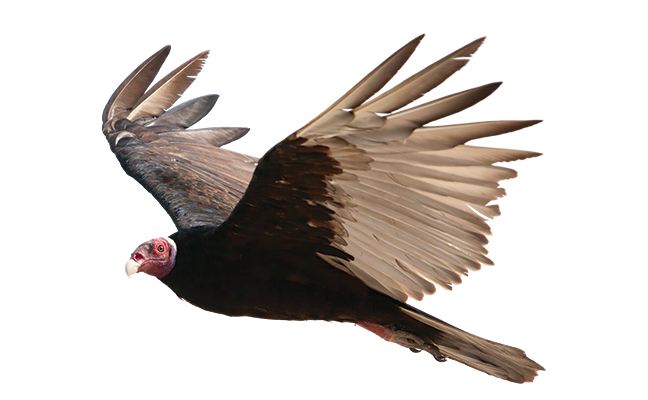Have you noticed an increase of turkey vultures (Cathartes aura) around your neck of the woods? Of course you have. That’s because their global population is more than 4.5 million, and growing daily. They can be found throughout the United States, Canada, the Caribbean, and down to the southernmost tip
of South America.
Also known as turkey buzzards, john crows and carrion crows, turkey vultures can look quite intimidating. Clients want them off their homes and commercial buildings immediately. These birds can damage homes by tearing up the shingles on the rooftop, and pecking and ripping through the protective roof membrane of commercial buildings. On top of that, they regurgitate and defecate all over the rooftops, too.
Treatment methods
Turkey vulture management strategy options depend on where they are roosting and nesting on the structure. The best way to eliminate turkey vultures nesting on commercial or residential rooftops is with an electrified shock system, we’ve found. To manage vultures nesting on a cell or water tower, we install bird netting on the entire structure so they can no longer roost or nest there.
One unusual, but effective method is to hang a dead effigy by its legs in the area in which the vultures have been frequenting. This often scares them away. You must have a permit from the U.S. Fish and Wildlife Services to use an effigy, however. We recommend always checking with your local, state and federal agencies to make sure you’re in compliance with the law. We also recommend contacting your local distributor or bird control supply company with any questions regarding control methods.
One last tip: When disturbed, these predators can project rotting, maggot-infested vomit as far as 10 ft. away. The smell of their vomit is so horrendous that it has caused humans to gag and vomit themselves. Try to stay upwind!
Turkey vultures are here to stay, especially now that their populations are growing. So gear up! These birds offer our industry great opportunities for humane removal.
12 turkey vulture facts
- Turkey vultures are scavengers, feeding primarily on carrion (from small to large dead mammals). They prefer dead roadkill and dead fish.
- They have a tremendous sense of smell, guiding them to their next meal.
- They fly low to the ground, so they can smell the gasses coming off of dead carcasses.
- Wingspans can extend up to 6 ft. wide; they stand 2.5 ft. tall, and weigh up to 4 lbs.
- They typically live to about 15 years in the wild, but have lived up to 0 years in captivity.
- In the United States, turkey vultures are a protected species under the Migratory Bird Treaty Act of 1918.
- They like to nest on dead trees, the tops of telephone poles, on rooftops, cliffs and billboards, and in forests, caves and open areas. They always appear in large groups.
- Both the male and female adult turkey vulture feed their young chicks with their own regurgitated food.
- When adult turkey vultures feel threatened, they will regurgitate on orin the direction of the intruder.
- They are permanent residents in the southern United States, and have been known to migrate from the northern U.S. to the South.
- You may see turkey vultures sitting on tree branches with their wings open wide. They are drying themselves off after getting wet.
- These vultures can fly up to 60 mph and fly/travel up to 200 miles in a day.
You can reach Donna and Stuart Aust, owners of Paramus, N.J.-based Bird Doctor, at stuart@bugdoctorinc.com.

Leave A Comment